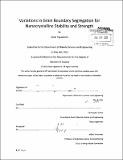Variations in grain boundary segregation for nanocrystalline stability and strength
Author(s)
Figueroa, Oscar, III
DownloadFull printable version (3.156Mb)
Other Contributors
Massachusetts Institute of Technology. Dept. of Materials Science and Engineering.
Advisor
Christopher Schuh.
Terms of use
Metadata
Show full item recordAbstract
In the last few decades, nanocrystalline metals have been of increasing interest. Their ability to show increased yield strength and uniform structure show them to be potentially useful in many applications. Additionally, nanocrystalline metals have become more easily manufactured in recent years, allowing for more testing and more use within industrial settings. However, nanocrystalline metals are still highly unstable, mainly due to temperature related growth. Grain boundary segregation is one way in which materials can keep nano length-scale grains. This process involves metal alloys that preferentially segregate the alloying material to the grain boundaries, potentially leading to Grain Boundary Embrittlement (GBE). Using an ideal work of fracture equation, [gamma] = 2[sigma]s - [sigma]g, the energy required to fracture nanocrystalline metal alloys was obtained, and predicted grain stability. Fracture toughness data is also calculated and compared. A contrast between bulk and nanocrystalline alloys is then made, showing benefits to the use of either set of materials for specific alloy functions.
Description
Thesis (S.B.)--Massachusetts Institute of Technology, Dept. of Materials Science and Engineering, 2012. Cataloged from PDF version of thesis. Includes bibliographical references (p. 39).
Date issued
2012Department
Massachusetts Institute of Technology. Department of Materials Science and EngineeringPublisher
Massachusetts Institute of Technology
Keywords
Materials Science and Engineering.